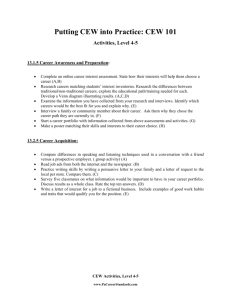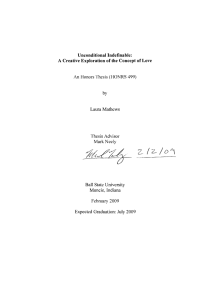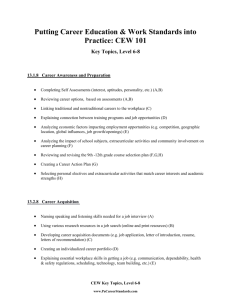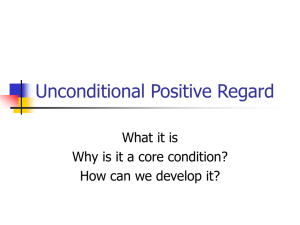Persistence, Predictability and Portfolio Planning M.J. Brennan – UCLA
advertisement
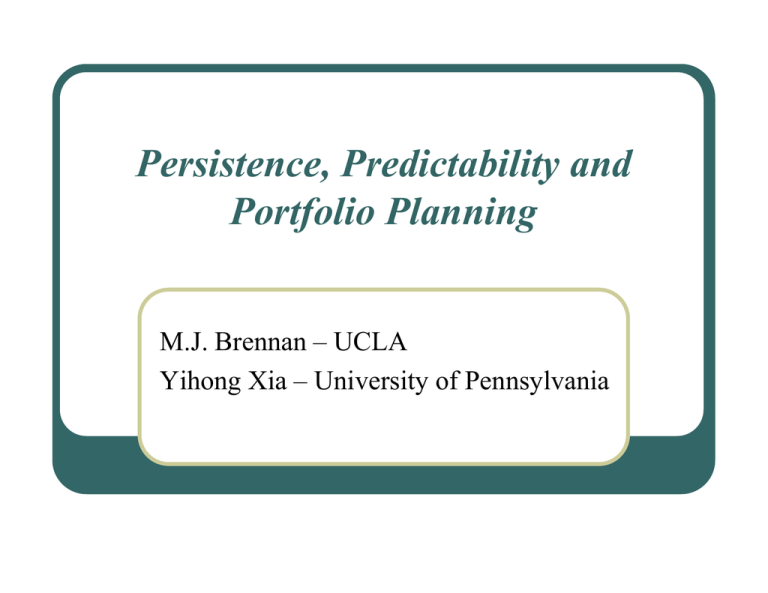
Persistence, Predictability and Portfolio Planning M.J. Brennan – UCLA Yihong Xia – University of Pennsylvania Stocks are sometimes cheap and sometimes dear. Important for long run investors? Price/10 year Average Earnings 1880-2003 50 45 2000 40 1929 Price-Earnings Ratio 35 30 1966 1901 25 20 15 10 5 0 1860 1880 1900 1920 1940 Year 1960 1980 2000 2020 Background z Academic studies have found: • stock returns predictable by such variables as Dividend yield, B/M, interest rates etc • z But virtually no out of sample return predictability Does this mean that investors should ignore time variation in returns and behave as though expected returns constant? z NO! We show that: z Return predictability that is of first order importance to long run investors will be: • • • z associated with large price variation. hard to detect using standard regression framework even when a perfect signal is available hard to estimate for portfolio planning purposes A promising alternative to popular academic predictors is forward looking forecasts of long run returns from DDM • Convert long run forecasts to short run A Simple Model of Return Predictability dP = μdt + σ P dzP P dμ = κ ( μ − μ )dt + σ μ dzμ Mean reverting expected return Parameters for simulations chosen so that: z Unconditional distribution of μ is fixed at • N ( μ = 9%,ν = 4%) varies a lot: 1 sigma interval (5% to 14%) z Consistent with a 14% annual stock return volatility z Risk free rate is constant at 3%, implying 6% equity premium. z Nine scenarios from the combination of κ = 0.02,0.10,0.5, and ρ = corr (dz P , dzu ) = 0.0,−0.5,−0.9 Strategy Use this (simulation) model to show this amount of expected return variability • Implies big variability in prices • Little short run return predictability an dis hard to • detect Possibly strong long run return predictability Later we will show: • The data consistent with this amount of predictability • How to exploit it P/D Ratios implied by the scenarios z z dD = gdt + σ D dz D D Expected Rate of Return: Dividend Process: ⎡ Ddt + dV ⎤ = μdt E⎢ ⎥ V ⎣ ⎦ z d μ = κ ( μ − μ ) dt + σ μ dz μ Differential equation allows us to solve for price as a function of dividend growth rate: P(D,μ) = Pv(μ) Dividend yields can vary a lot as μ changes even though dividend growth assumed constant (g = 1.85%) 10% 9% mubar-sig mubar mubar+sig 8% 7% 6% 5% c 4% 3% 2% 1% 0% 1 2 3 4 5 6 7 8 9 z Under our scenarios • Prices vary a lot • Expected returns vary a lot (5%-13%) z Are we likely to detect this predictability by regressing returns on (or proxies for )? R(t , t + τ ) = a + bμt + ε t ,t +τ Distribution of corrected t-ratios on the predictor using 70 years of simulated monthly returns 3 25% Median 75% 2.5 2 1.5 1 0.5 0 1 2 3 4 5 Scenario 6 7 8 9 R2 (%) in an Annual Return Predictive Regression (70-years simulated returns) 14 25% 12 Median 75% 10 8 6 4 2 0 1 2 3 4 5 6 7 8 9 R2 as a function of horizon for different values of κ and ρ 0.8 k =0.02,r h0=-0.9 k =0.10,r h0=-0.9 0.7 k =0.50,r h0=-0.9 k =0.02,r h0=-0.5 k =0.10,r h0=-0.5 k =0.50,r h0=-0.5 0.6 k =0.02,r h0=0.0 k =0.10,r h0=0.0 k =0.50,r h0=0.0 0.5 0.4 0.3 0.2 0.1 0.0 1 2 3 4 5 6 7 8 9 10 11 12 Years 13 14 15 16 17 18 19 20 z Short run predictability is hard to detect and measure. z Would it be valuable if we could detect it? e.g observe Economic Value of Market Timing z z Investor is assumed to maximize expected CRRA utility (RRA = 5) over terminal wealth. Measure economic value using certainty equivalent wealth ratio between different strategies (CEWR) • Optimal dynamic strategy • Myopic strategy • Unconditional strategy Value of (optimal) dynamic strategy relative to unconditional strategy: CEW(O)/CEW(U) (T=20, σP=0.14, σμ=0.04, μ = 9%=mubar) Scenario (vi) ρ=-0.9, κ=0.1 1.6 1.5 CEWR 1.4 1.3 1.2 1.1 1 0.5 -0.9 rho 0.1 -0.5 0 0.02 kappa Value of (optimal) dynamic strategy relative to myopic strategy: CEW(O)/CEW(M) (T=20, σP=0.14, σμ=0.04, μ = 9%=mubar) Scenario (vi) ρ=-0.9, κ=0.1 1.60 1.40 1.30 1.20 1.10 1.00 -0.9 rho 0.5 -0.5 0.1 0 0.02 kappa CEW Ratio 1.50 Value of Market Timing (CEWRou) for Investors with 20-year horizon 1 year R2 tells us nothing about value of timing 1.6 κ=0.5 ρ=-0.9 1.5 R2=4.8% CEW R ou 1.4 κ=0.1 ρ=-0.9 κ=0.5 ρ=-0.5 1.3 κ=0.02 ρ=-0.9 R2=7.4% 1.2 κ=0.5 ρ=0.0 1.1 1.0 0.04 0.045 0.05 0.055 0.06 One-Year R 0.065 2 0.07 0.075 0.08 z Market timing valuable if we could observe . z But in practice we can only rely on proxies for (dividend yields) and badly estimated regression coefficients. z A better approach is to rely on direct estimates of that do not rely on regression estimates A Forward-Looking Method: DDM Model z DCF approach ∞ Pt = ∑ τ =1 Et [ Dt +τ ] (1 + k ) τ t • Forecasts of future dividends provided by analysts yield current estimates of long run expected returns on stocks, kt • Problem: How to map k into short run expected rate of return μ dμ = κ (μ − μ )dt + σ dz μ μ DDM approach to estimating z If we know the parameters of the Vasicek interest rate model we can infer the short rate, r, from the long rate, l. z In same way, if we know the parameters of dμ = κ ( μ − μ )dt + σ μ dzμ z z we can infer from kt Iterative procedure for inferring and updating parameters Also estimate model in which dividend growth rate follows OU process: Four DDM k series • Arnott & Bernstein (A&B) (2002), and Ilmanen (IL) (2003) • 1950.1 - 2002.2 quarterly • real, ex-post (back-casted) • based on smoothed GDP growth rate • Barclays Global Investors (BGI) and Wilshire Associates (WA) • 1973.1 to 2002.2 monthly – converted to quarterly • nominal, ex-ante (real time) • using I/B/E/S consensus estimates Estimates of μ from the WA DDM k series (1973.Q1 to 2002.Q2) 30% 25% k4 μ4,1 μ4,2 20% 15% 10% 5% 0% 1973 -5% 1976 1979 1982 1985 1988 1991 1994 1997 2000 200303 Estimated μ process parameters z Similar across 4 models and Close to scenario (vi) Real Nominal Scenario (A&B) (IL) (BGI) (WA) (vi) κμ 0.085 (0.083) 0.122 (0.115) 0.091 (0.085) 0.122 (0.095) 0.1 σμ 0.017 (0.017) 0.0196 (0.022) 0.024 (0.021) 0.034 (0.027) 0.018 νμ 0.042 (0.042) 0.040 (0.047) 0.056 (0.052) 0.068 (0.061) 0.04 ρμP -0.98 (-0.98) -0.88 (-0.89) -0.81 (-0.66) -0.68 (-0.71) -0.9 Statistical Significance: In-Sample Quarterly Predictive Regressions z Regression: ⎡1.0 − e −0.25κ ⎤ i , 2 R(t , t + 0.25) = a0 + a1 ⎢ ⎥ μt + ε t κ ⎣ ⎦ i = 1 (A & B), 2 (IL), 3 (BGI),4 (WA) z Theoretical value: a1=1.0 In-Sample Quarterly Predictive Regressions Results Predictor a_1 H0: a_1=1 R2 (%) N μ1,2 0.874 [1.60] 1.43 209 (1950.Q2 – 2002. Q2) μ2,2 0.701 [1.27] 1.12 209 (1950.Q2 - 2002. Q2) μ3,2 1.026 [1.69] 2.89 117 (1973.Q2 to 2002.Q2) μ4,2 0.924 [1.66] 2.74 117 (1973.Q2 to 2002.Q2) Economic Importance: Simulation of Market Timing and Unconditional Strategies z RRA = 5 Unconditional Strategy: z Optimal Market Timing: z x* = x* = μ −r γσ t 2 P z z Risky asset: S&P500 Riskless asset: 30 day T-Bill μ −r γσ P2 plus hedging terms Proportion of Wealth Invested in Stocks 1.2 Unconditional (based on full sample mean) Unconditional (based on gradually updated sample mean) Optimal 1.0 0.8 0.6 0.4 0.2 0.0 Mar-73 Mar-75 Mar-77 Mar-79 Mar-81 Mar-83 Mar-85 Mar-87 Mar-89 Mar-91 Mar-93 Mar-95 Mar-97 Mar-99 Mar-01 Wealth under optimal and unconditional Strategies for a 20-year horizon constrained investor using μ4,2 (RRA = 5, 1973.Q2 -1993.Q1) 12 10 uncondtional optimal 8 6 4 2 0 Sep-73 Sep-75 Sep-77 Sep-79 Sep-81 Sep-83 Sep-85 Sep-87 Sep-89 Sep-91 Wealth under optimal and unconditional Strategies for a 9-year horizon constrained investor using μ4,2 (RRA = 5, 1993.Q2 - 2002.Q2) 2.5 2.0 Unconditional Optimal 1.5 1.0 0.5 0.0 Jun-93 Jun-95 Jun-97 Jun-99 Jun-01 Wealth under optimal and unconditional Strategies for a 29-year horizon constrained investor using μ4,2 (RRA = 5, 1973.Q2 – 2002.Q2) 25 20 uncondtional optimal 15 10 5 0 Jun-73 Jun-76 Jun-79 Jun-82 Jun-85 Jun-88 Jun-91 Jun-94 Jun-97 Jun-00 Conclusion z Time-varying expected returns economically important, even though • Hard to detect, measure z Substantial benefit from the optimal strategy z DDM discount rates are a useful input for long run investor. z Long run investors (pension, insurance) should hedge against changes in investment opportunities.

